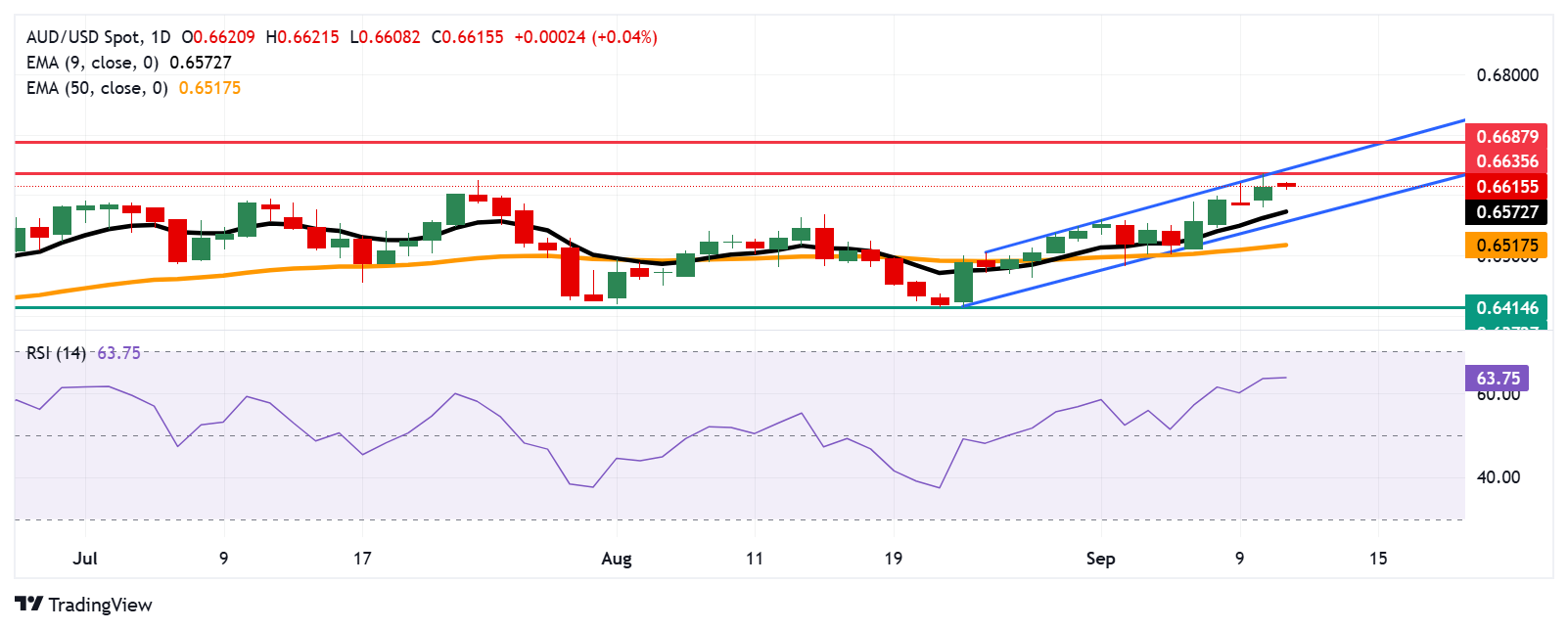Australian Dollar holds losses following Consumer Inflation Expectations
- Australian Dollar edges lower despite Consumer Inflation Expectations rising to 4.7% in September.
- The AUD finds support as swaps priced in an 86% chance that the RBA will leave policy unchanged in September.
- The US Dollar could experience weakness as softer PPI boosts Fed easing prospects for September.
The Australian Dollar (AUD) inches lower on Thursday after registering gains in the previous session. The AUD/USD pair may regain its ground as the US Dollar (USD) could face challenges as traders expect a stronger US Federal Reserve (Fed) easing in September, following softer-than-estimated US Producer Price Index (PPI) data. Traders shift their focus to the US Consumer Price Index (CPI) for August due later in the North American session.
Australia’s Consumer Inflation Expectations climbed to 4.7% in September from August’s five-month low of 3.9%. The increase reflected stronger domestic demand, which in turn heightened concerns over renewed inflationary pressures. RBA Governor Michele Bullock highlighted that the private sector has begun to show “a little bit more growth,” which she described as positive for the economy.
The AUD received support as solid recent key economic data from Australia weakened expectations of additional Reserve Bank of Australia (RBA) rate cuts. Swaps are now assigning nearly an 86% probability that the RBA will keep policy unchanged in September.
Australian Dollar falls as US Dollar stays firm despite priced-in Fed rate cut
- The US Dollar Index (DXY), which measures the value of the US Dollar against six major currencies, is holding ground around 97.80 at the time of writing. The Greenback faces challenges as traders widely expect a rate cut in September, marking a restart to the Fed's easing cycle.
- Markets are now fully pricing in a 25 basis points (bps) rate cut at the Fed's September meeting, while the chance of a larger 50 bps reduction has also risen to nearly 12%, according to the CME FedWatch tool.
- The US Bureau of Labor Statistics (BLS) reported on Wednesday that the US PPI inflation declined to 2.6% on a yearly basis in August from 3.3% in July. This figure came in below the market consensus of 3.3%. On a monthly basis, the PPI declined by 0.1% in August, compared to the 0.7% increase (revised from 0.9%) prior.
- According to the US Bureau of Labor Statistics (BLS), the preliminary estimate of the Current Employment Statistics (CES) national benchmark revision suggests total Nonfarm employment for March 2025 will likely be revised down by 911,000, or about 76,000 fewer jobs per month, signaling a weaker labor market than previously estimated. The final benchmark revision will be issued in February 2026 with the publication of the January 2026 Employment Situation news release," the BLS noted in its press release.
- Federal Reserve (Fed) Bank of Chicago President Austan Goolsbee said in an interview on Bloomberg TV on Friday that he is still unsure whether September is the right time for an interest rate cut, following weaker jobs data. He added that high inflation data is still cause for concern, and key Fed officials may not be fully sold on a September rate cut.
- China’s Consumer Price Index (CPI) declined 0.4% year-over-year in August after arriving at 0% in July. The market consensus was for a 0.2% decline in the reported period. The monthly CPI inflation came in at 0% versus the previous 0.4% and the expected 0.1% increase. Any Chinese economic change could impact the AUD as China and Australia are close trading partners.
- Matthew Hassan, Head of Australian Macro-Forecasting, noted that consumer recovery since mid-2024 has been sluggish, following a decline in Westpac Consumer Confidence to 95.4 in September from 98.5 in August. Hassan indicated that further policy easing may be required, projecting a 25-basis-point RBA rate cut in November, followed by two additional reductions in 2026.
Australian Dollar remains above 0.6600 support after pulling back from 10-month highs
AUD/USD is trading around 0.6620 on Thursday. The technical analysis of the daily chart shows the pair remains within the ascending channel pattern, suggesting a persistent bullish bias. Additionally, the pair lies above the nine-day Exponential Moving Average (EMA), indicating short-term price momentum is stronger.
The primary resistance lies at the 10-month high of 0.6635, which was recorded on September 10, followed by the upper boundary of the ascending channel at around 0.6650. A break above this crucial resistance zone would strengthen the bullish bias and support the AUD/USD pair to a move toward the 11-month high of 0.6687, recorded in November 2024.
On the downside, the AUD/USD pair may find initial support at the nine-day EMA of 0.6572, aligned with the ascending channel’s lower boundary around 0.6560. A break below the channel would weaken the bullish bias and prompt the pair to test the 50-day EMA at 0.6517. Further declines would dampen the medium-term price momentum and put downward pressure on the pair to navigate the region around the three-month low of 0.6414, recorded on August 21.
AUD/USD: Daily Chart

Australian Dollar Price Today
The table below shows the percentage change of Australian Dollar (AUD) against listed major currencies today. Australian Dollar was the weakest against the New Zealand Dollar.
| USD | EUR | GBP | JPY | CAD | AUD | NZD | CHF | |
|---|---|---|---|---|---|---|---|---|
| USD | -0.03% | 0.03% | 0.07% | 0.04% | 0.07% | -0.07% | 0.01% | |
| EUR | 0.03% | 0.05% | -0.02% | 0.07% | 0.06% | -0.01% | 0.00% | |
| GBP | -0.03% | -0.05% | -0.06% | -0.03% | -0.05% | -0.06% | -0.05% | |
| JPY | -0.07% | 0.02% | 0.06% | 0.02% | 0.03% | -0.01% | 0.00% | |
| CAD | -0.04% | -0.07% | 0.03% | -0.02% | -0.10% | -0.08% | -0.02% | |
| AUD | -0.07% | -0.06% | 0.05% | -0.03% | 0.10% | -0.07% | -0.06% | |
| NZD | 0.07% | 0.01% | 0.06% | 0.01% | 0.08% | 0.07% | -0.00% | |
| CHF | -0.01% | -0.00% | 0.05% | -0.01% | 0.02% | 0.06% | 0.00% |
The heat map shows percentage changes of major currencies against each other. The base currency is picked from the left column, while the quote currency is picked from the top row. For example, if you pick the Australian Dollar from the left column and move along the horizontal line to the US Dollar, the percentage change displayed in the box will represent AUD (base)/USD (quote).
Australian Dollar FAQs
One of the most significant factors for the Australian Dollar (AUD) is the level of interest rates set by the Reserve Bank of Australia (RBA). Because Australia is a resource-rich country another key driver is the price of its biggest export, Iron Ore. The health of the Chinese economy, its largest trading partner, is a factor, as well as inflation in Australia, its growth rate and Trade Balance. Market sentiment – whether investors are taking on more risky assets (risk-on) or seeking safe-havens (risk-off) – is also a factor, with risk-on positive for AUD.
The Reserve Bank of Australia (RBA) influences the Australian Dollar (AUD) by setting the level of interest rates that Australian banks can lend to each other. This influences the level of interest rates in the economy as a whole. The main goal of the RBA is to maintain a stable inflation rate of 2-3% by adjusting interest rates up or down. Relatively high interest rates compared to other major central banks support the AUD, and the opposite for relatively low. The RBA can also use quantitative easing and tightening to influence credit conditions, with the former AUD-negative and the latter AUD-positive.
China is Australia’s largest trading partner so the health of the Chinese economy is a major influence on the value of the Australian Dollar (AUD). When the Chinese economy is doing well it purchases more raw materials, goods and services from Australia, lifting demand for the AUD, and pushing up its value. The opposite is the case when the Chinese economy is not growing as fast as expected. Positive or negative surprises in Chinese growth data, therefore, often have a direct impact on the Australian Dollar and its pairs.
Iron Ore is Australia’s largest export, accounting for $118 billion a year according to data from 2021, with China as its primary destination. The price of Iron Ore, therefore, can be a driver of the Australian Dollar. Generally, if the price of Iron Ore rises, AUD also goes up, as aggregate demand for the currency increases. The opposite is the case if the price of Iron Ore falls. Higher Iron Ore prices also tend to result in a greater likelihood of a positive Trade Balance for Australia, which is also positive of the AUD.
The Trade Balance, which is the difference between what a country earns from its exports versus what it pays for its imports, is another factor that can influence the value of the Australian Dollar. If Australia produces highly sought after exports, then its currency will gain in value purely from the surplus demand created from foreign buyers seeking to purchase its exports versus what it spends to purchase imports. Therefore, a positive net Trade Balance strengthens the AUD, with the opposite effect if the Trade Balance is negative.

